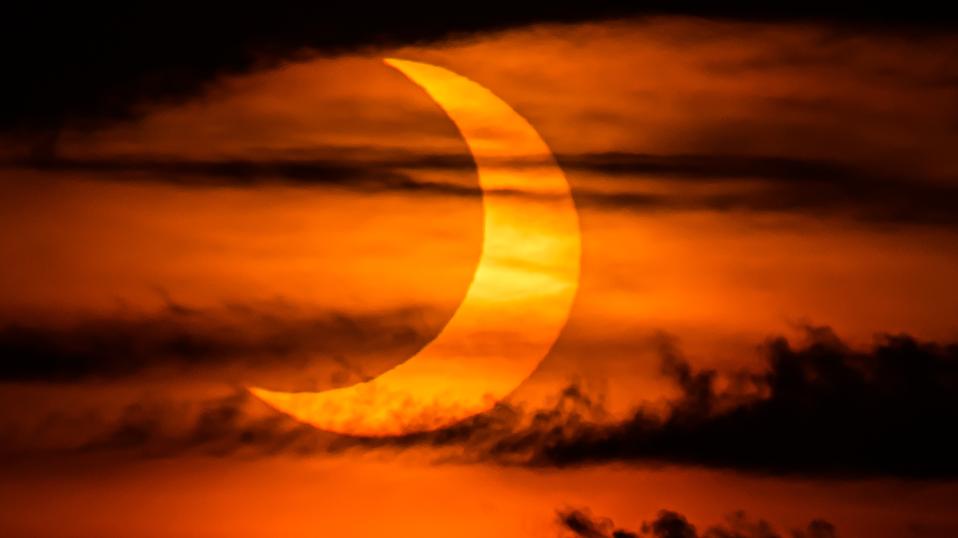


The first solar eclipse of 2025 arrives this Saturday, March 29, bringing a deep partial solar eclipse to North America at sunrise and a smaller eclipse in mid-morning to western Europe, northwest Africa and Russia. While this will be the best solar eclipse of the year in the Northern Hemisphere, it’s also potentially dangerous because at no point will the sun be completely covered by the moon. Since looking at a partially eclipsed sun can cause eye damage, all observers will need eclipse glasses leftover from last year’s total solar eclipse. The event comes two weeks after a “blood moon” total lunar eclipse was seen across North America and from the moon.
The sun rises over New York City during a solar eclipse on June 10, 2021 as seen from The Edge ... More
This partial solar eclipse will be seen in some form across northeastern North America (where the sun will rise in partial eclipse), Greenland, Iceland, Western Europe and parts of northern Russia (where the sun will set in partial eclipse).
The entire event will last three hours and 53 minutes, beginning at 8:50 UTC (4:50 a.m. EDT) and ending at 12:43 UTC (8:43 a.m. EDT), though exactly what will be experienced from specific locations can be found on Timeanddate.com’s Eclipse Calculator.
The event — during which the moon’s central shadow will slightly miss Earth — will see greatest eclipse in Akulivik, an Inuit village in Nunavik, northern Quebec, Canada, where 93.8% of the sun’s disk will be covered by a new moon at sunrise.
Since the sun will never be fully covered, eclipse glasses or solar filters are required at all times. Never use sunglasses. Photographers should use solar filters. Certified safe suppliers can be found on the American Astronomical Society’s Suppliers of Safe Solar Filters & Viewers list.
Observers in the northeastern U.S. and eastern Canada will have a chance of witnessing the striking visual effect of a partially eclipsed sun rising, with the sun’s disk appeearing on the horizon already partially covered by the moon. For a chance to see this phenomenon, observers need to choose a location with a low view of the eastern horizon, preferably on the coast, with sightlines to the sunrise.
From locations on a line (that divides night from day) stretching southeast from Nunavik south through Quebec, southwest New Brunswick, Canada, and eastern Maine, U.S., it will be possible to see a horizontal “smiley face” sunrise crescent appear on ocean horizon. During the oments of sunrise, two cusps of the sun will rise separately, causing a rare “double sunrise” effect.
Favored locations include Forestville, Quebec, Saint Andrews, New Brunswick, and Quoddy Head State Park, Maine (the easternmost point of the U.S.). From these locations, the cusps of the crescent sun will appear to rise separately, with the moon blocking out the sun’s disk between.
This partial eclipse comes three years and nine months after a similar eclipse on June 10, 2021, when an annular solar eclipse in far north Ontario in Canada, Greenland and Russia caused a partially eclipsed sun at sunrise for northeaster U.S. states. Toronto, Philadelphia, New York and Boston all saw a 70%+ eclipsed sunrise.
This is the first and final solar eclipse for North America in 2025. The next solar eclispe, also a partial, will occur on Sunday, Sept. 21 and be visible only in the Southern Hemisphere. The best places to see it will be in Antarctica and New Zealand, with thelatter seeing as much as 73% of the sun blocked by the moon. That will be the final purely partial solar eclipse on Earth until 2029, with 2026, 2027 and 2028 all containing central eclipses — total solar eclipses and “ring of fire” annular solar eclipses. However North America will experience a small partial solar eclipse during the total solar eclipse on Aug. 12, 2026, which will bring totality to parts of Greenland, Iceland and Spain. The next total solar eclipse in the U.S. will come to Alaska on March 30, 2033.

